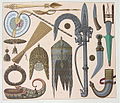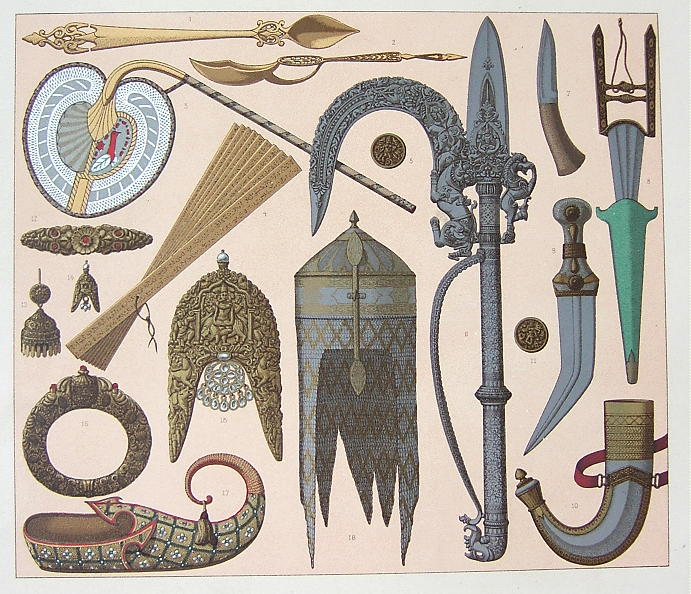File:Racinet2.jpg
Page contents not supported in other languages.
Tools
Actions
General
In other projects
Appearance
Racinet2.jpg (691 × 594 pixels, file size: 120 KB, MIME type: image/jpeg)
| This is a file from the Wikimedia Commons. Information from its description page there is shown below. Commons is a freely licensed media file repository. You can help. |
Summary
| Artist |
ALBERT RACINET, Paris |
| Description |
"India, that country full of luxurious vegetation, rich in natural products of every kind, with inexhaustible mines of precious metals and stones, displays her character of overflowing abundance and the fantastic spirit of her inhabitants also in the productions of her art. But notwithstanding her old and comparatively high civilization, a certain conservatism, extending for nearly a thousand years to the social and religious conditions and, institutions, exercised, as a matter of course, its unavoidable influence also on the artistic productions, especially when you look on the caste-like separation of the several trades. Only since the beginning of our century can we report new introductions in the Indian art. Being little conventional and flowing freely, Indian ornament - seems to have the greatest affinity with the Persian style. The surface decoration, never losing its specific character, mostly exhibits a very profuse richness of recurring motives, and a grand splendour of colouring which, far from harassing the eyes of the beholder, affords, on the contrary, a salutary repose to them. The outlines of the design, in which all modelling is avoided, are generally executed on light ground in deeper colours than the pattern itself, and on dark ground-in light colours. The Indians found their principal motives, as seems most likely, among their native plants, employing in the first place lotus, excellently drawn roses, pinks, granates, etc.; but most frequently, especially in modern productions, we meet with the palm-branch always-treated conventionally. Fig. 1 and 2. Wooden spoons from Calcutta used for cream, Fig. 3. Bengalese fan used in Indian homes. The handle is made of wood, the fan part of silk and satin. The first fans used in India were made of palm leaves. They were used against flies, also a tail of the yak (Tibetan steer)) was used for this purpose, Fig. 4. depicts a book made of elongated wooden tablets tied together with a wire, Figs. 5, 11, 12, 13, 14, 15, and 16. depict various buttons, brooches, buckles made of embossed and chiseled gold, embellished with various precious stones, diamonds and pearls, Fig. 6. Antique steel hook used by elephant riders, Fig. 7. Little knife from Nepal, Fig. 8. A khouttar, Indian dagger, distinguished by its sheath covered with velvet. This weapon is only known in Hindustan, Figs. 9 and 10. Another dagger with a bent-shaped blade, strengthened along its length with a raised rib. This type of dagger was not attached to a belt but was carried hanging from it, Fig. 17. Depicts a shoe of a nahab. The fabric is made of golden filaments, embroidered with silk and pearls, Fig. 18. A helmet of a mogul from the 16th Century, the top is highlighted by a pyramid-shaped button, the front has the nose protector." |
| Date |
1878 date QS:P571,+1878-00-00T00:00:00Z/9 |
| Source/Photographer | http://www.columbia.edu/itc/mealac/pritchett/00routesdata/1700_1799/localrulers/weapons/xracinet.html |
Licensing
| Public domainPublic domainfalsefalse |
This work is in the public domain in France for one of the following reasons:
العربية ∙ English ∙ español ∙ français ∙ 日本語 ∙ 한국어 ∙ македонски ∙ русский ∙ Tiếng Việt ∙ 简体中文 ∙ 繁體中文 ∙ +/− |
 |
File history
Click on a date/time to view the file as it appeared at that time.
| Date/Time | Thumbnail | Dimensions | User | Comment | |
|---|---|---|---|---|---|
| current | 12:16, 23 October 2011 |  | 691 × 594 (120 KB) | Sridhar1000 | ............. |
| 04:51, 30 September 2011 |  | 691 × 594 (120 KB) | Sridharbabu1000 |
File usage
Global file usage
The following other wikis use this file:
- Usage on bn.wikipedia.org
- Usage on hy.wikipedia.org
- Usage on it.wikipedia.org
- Usage on ms.wikipedia.org
- Usage on pt.wikipedia.org
- Usage on ru.wikipedia.org
- Usage on ta.wikipedia.org
- Usage on uk.wikipedia.org
Metadata
This file contains additional information, probably added from the digital camera or scanner used to create or digitize it.
If the file has been modified from its original state, some details may not fully reflect the modified file.
| Image title | Sierra Exif JPEG |
|---|---|
| Camera manufacturer | TOSHIBA |
| Camera model | PDRM81 |
| Exposure time | 1/75 sec (0.013333333333333) |
| F-number | f/2.9 |
| ISO speed rating | 100 |
| Date and time of data generation | 15:16, 14 May 2002 |
| Orientation | Normal |
| Horizontal resolution | 72 dpi |
| Vertical resolution | 72 dpi |
| Software used | Digital Camera PDRM81 Ver1.10 |
| File change date and time | 19:53, 18 June 2007 |
| Y and C positioning | Co-sited |
| Exposure Program | Normal program |
| Exif version | 2.1 |
| Date and time of digitizing | 15:16, 14 May 2002 |
| Meaning of each component |
|
| Shutter speed | 6.2 |
| APEX aperture | 3.1 |
| Exposure bias | 0 |
| Maximum land aperture | 3.1 APEX (f/2.93) |
| Metering mode | Spot |
| Light source | Unknown |
| Flash | Flash did not fire |
| Supported Flashpix version | 1 |
| Color space | sRGB |
| File source | Digital still camera |
Retrieved from "https://en.wikipedia.org/wiki/File:Racinet2.jpg"

